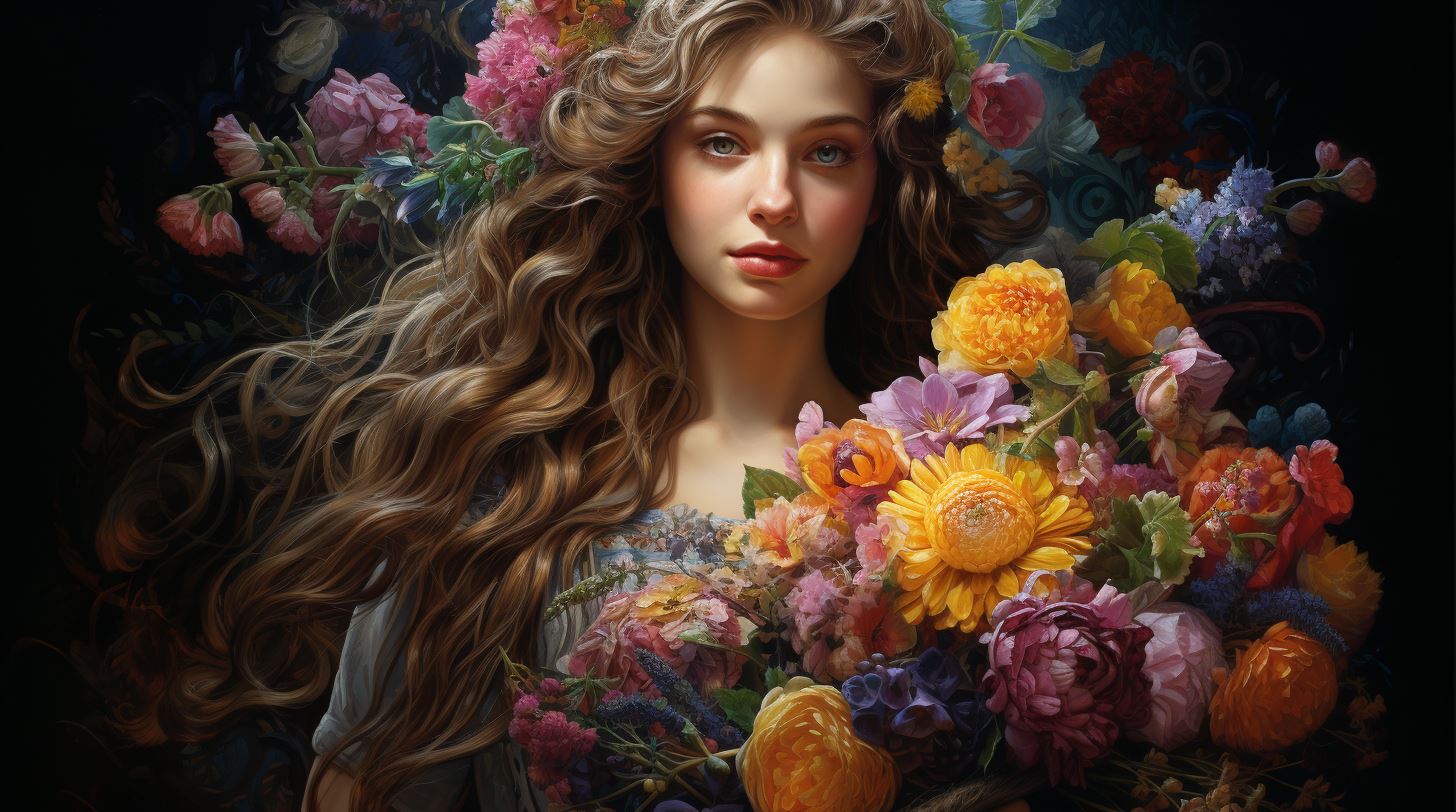Creiddylad Goddess: Unveiling the Eternal May Queen of Love and Flowers

Creiddylad goddess is a Welsh deity associated with flowers and love. Her story, mentioned in The Mabinogion, centers around her abduction by Gwyn ap Nudd, leading to a battle between suitors.
King Arthur’s intervention prohibited any marriage, resulting in a yearly battle symbolizing the cycles of life, death, and rebirth. The Oak King and Holly King, represented by oak and holly trees, personify the battle between light and darkness.
Creiddylad’s connection with Cordelia, her daughter, celebrates Beltane. A spell for peace and tranquility involves anointing candles or objects with lavender, chamomile, and ylang ylang oils. Creiddylad’s presence is briefly mentioned in the Breton pantheon.
The Story of Creiddylad: A Welsh Goddess of Flowers and Love
Creiddylad, the Welsh Goddess of Flowers and Love, embodies the essence of eternal beauty and affection. Her story, deeply rooted in Welsh mythology, unveils a captivating narrative of conflict, intervention, and symbolism.
Creiddylad’s Abduction: Battle between Gwythyr ap Greidawl and Gwyn ap Nudd
In the realm of love and desire, Creiddylad became the center of a captivating battle. She was promised to Gwythyr ap Greidawl, but fate had a different plan in store. Gwyn ap Nudd, driven by his own desires, chose to abduct Creiddylad, igniting a clash between the two suitors.
King Arthur’s Intervention: The Prohibition of Marriage
The intensity of the situation brought the legendary King Arthur to intervene, invoking his authority to settle the dispute. Recognizing the complexity of the situation, King Arthur decreed that neither Gwythyr nor Gwyn could marry Creiddylad.
This proclamation marked a significant turning point in the story, as it solidified the eternal struggle and rivalry between the two suitors.
The Symbolism of the Yearly Battle: Life, Death, and Rebirth
The yearly battle that ensued between Gwythyr and Gwyn, sparked by King Arthur’s ruling, carried profound symbolic weight.
This cyclic conflict mirrored the natural order of life, death, and rebirth, embodying the eternal cycle of existence. Each year, at the auspicious time of Beltane or May Day, the battle between the suitors would commence, perpetuating the cosmic balance between love, desire, and loss.
Embraced within the folds of this captivating story, Creiddylad’s tale of love and devotion reverberates through the tapestry of Welsh mythology. Her abduction, King Arthur’s intervention, and the perpetual battle between suitors paint a vivid portrait of the complexities and depth of human emotions.
The Oak King and Holly King: Personifying the Battle between Light and Darkness
The ancient Celtic mythology portrays the perpetual struggle between light and darkness through the mythological figures known as the Oak King and Holly King. These two archetypes symbolize the changing seasons and the eternal cycle of life.
The Role of the Oak Tree and Holly Tree
The Oak King represents the power of light and growth, ruling over the fertile months of the year when life blossoms. The mighty oak tree, with its towering presence and sturdy branches, embodies strength and endurance.
It stands as a symbol of vitality and regrowth, representing the triumph of light over darkness.
On the other hand, we have the Holly King, who reigns during the darker months of the year when nature withdraws into a dormant state.
The holly tree, with its evergreen leaves and sharp prickly edges, symbolizes protection and resilience. It represents the power of darkness and the necessary rest before new beginnings.
Throughout the year, the Oak King and Holly King engage in an eternal battle, each taking turns to hold dominion over the seasons.
Their cyclical struggle mirrors the ebb and flow of light and darkness, reminding us of the inherent balance in the natural world.
The May Queen’s Representation through the Ivy Plant
Within this cosmic battle stands the May Queen, represented by the graceful and ever-entwining ivy plant. As a goddess of flowers and love, Creiddylad embodies the enduring power of life, renewal, and fertility.
The ivy, with its vibrant green leaves and ability to cling and climb, symbolizes the strength and tenacity of love.
Just as the May Queen reigns during the month of May, when nature bursts forth in full bloom, the ivy represents the vitality and regenerative energy associated with this time.
It serves as a reminder of the life-giving force of love and the continuous cycle of growth and abundance.
Through the intertwining of the Oak King, Holly King, and the May Queen, the myth of Creiddylad goddess unfolds, revealing the eternal dance between light and darkness, life and death, growth and dormancy.
It is a timeless tale that reminds us of the interconnectedness of all things, and the inherent balance required for the harmony of existence.
Creiddylad’s Association with Cordelia: Exploring their Connection to Flowers and Love
Cordelia, as the daughter of Creiddylad, holds a significant role in the Welsh mythology and is celebrated during Beltane, also known as May Day.
This joyous occasion marks the arrival of spring and the blossoming of flowers, symbolizing the vitality of love and the renewal of life.
Cordelia as the Daughter of Creiddylad: Celebrated during Beltane
Cordelia, a beloved figure in Welsh folklore, embodies the essence of beauty and romance, inherited from her mother Creiddylad.

During the vibrant festival of Beltane, Cordelia’s presence is cherished and revered, as she represents the enchanting power of nature in full bloom.
This celebration serves as a tribute to the eternal cycle of life and love, where the delicate embrace of Cordelia’s spirit intertwines with the vibrant colors and fragrant scents of blooming flowers.
Through joyful rituals and dancing, believers seek to invoke Cordelia’s blessings of love, fertility, and abundance for the year to come.
Creating an Altar to Invoke Cordelia’s Presence and Attract Fairies
To invoke Cordelia’s presence and create a sacred space for her essence to flourish, one can construct a beautiful altar adorned with herbs, straw, and an abundance of fragrant flowers.
This altar serves as a channel to connect with the divine and attract the presence of fairies, who are believed to be messengers of Cordelia.
- Select a serene location for your altar, preferably outdoors, where the energy of nature can enhance the spiritual connection.
- Gather fresh herbs, such as lavender and chamomile, known for their soothing and calming properties, adding them to the altar table.
- Spread a thin layer of straw as a symbol of fertility, signifying the abundant growth and flourishing love associated with Cordelia.
- Arrange an assortment of vibrant flowers, such as roses, daisies, and lilies, creating a colorful tapestry of beauty that represents Cordelia’s essence.
By dedicating this sacred space to Cordelia, one can seek her guidance in matters of the heart, invite her enchanting presence into their lives, and foster a deeper connection with the everlasting power of love.
Spell for Peace and Tranquility: Anointing Candles and Objects with Lavender, Chamomile, and Ylang Ylang Oils
In the realm of harnessing serenity and calmness, a spell for peace and tranquility can work wonders. By utilizing the power of essential oils, particularly lavender, chamomile, and ylang-ylang, you can create an atmosphere of harmony and balance.
To perform this spell, gather the following ingredients:
- Lavender essential oil
- Chamomile essential oil
- Ylang-ylang essential oil
- A base oil, such as almond or jojoba oil
Begin by preparing a quiet space where you can focus your energy.
Clear your mind and set your intention to invite peace and tranquility into your life.
In a small bottle, combine a few drops of lavender, chamomile, and ylang-ylang essential oils. Blend them gently with the base oil, creating a harmonious mixture.
As you mix the oils, infuse them with your affirmations for peace and tranquility. Visualize a serene environment and imagine yourself surrounded by a calming aura.
Once the oils are blended and consecrated with your intention, they can be used to anoint candles or objects that hold significance for you.
Light the candles and place them in your sacred space, allowing their gentle glow to create an ambiance of relaxation.
You can also anoint objects such as crystals, amulets, or even yourself with the oil mixture.
As you do so, repeat your affirmations and envision the peaceful energy infusing into the items and your being.
This spell can be performed during times of stress, before meditation or sleep, or whenever you desire to cultivate tranquility in your life.
The aroma of the essential oils combined with the intention behind the spell can help promote a sense of peace and balance within you.
Remember to store the oil mixture in a cool, dark place when not in use to preserve its potency.
Revisit this spell whenever you feel the need to reconnect with inner calm and embrace the serenity it brings.
Creiddylad in Breton Pantheon: Brief Mention without Further Information
In addition to her prominence in Welsh mythology, Creiddylad also holds a place in the Breton pantheon, although limited information is available about her role and significance within this particular tradition.
While her mention in the Breton pantheon sparks intrigue, further details remain undisclosed.
The fragmented nature of Creiddylad’s association in Breton mythology leaves much to interpretation and exploration. Without additional accounts or myths directly related to Creiddylad in the Breton context, her role and significance in this particular pantheon appear to be enigmatic and open to individual interpretation.
Though the mention of Creiddylad in the Breton pantheon hints at potential connections and similarities between different Celtic mythologies, it leaves readers longing for more comprehensive information regarding her specific attributes, relationships, and myths within the Breton culture.
.



















